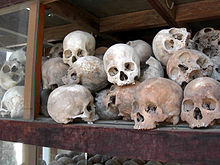Son Sen
Son Sen | |
|---|---|
Deputy Prime Minister of Democratic Kampuchea | |
| In office 14 April 1976 – 7 January 1979 | |
| Prime Minister | Pol Pot |
| Personal details | |
| Born | 12 June 1930 Oddar Meanchey, Cambodia |
| Cause of death | Execution by shooting |
| Political party | Communist Party of Kampuchea |
| Spouse | Yun Yat |
Son Sen (
Son Sen was responsible for ordering the massacre of more than 100,000 people in the Eastern Zone of Cambodia during the last six months of 1978.[3]
Sen was married to Yun Yat, who became the Party's minister of education and information. Along with the rest of his family, he was killed on the orders of Pol Pot during a 1997 factional split in the Khmer Rouge.
Early life
Son Sen was born in the village of Huong Hoa,
Sen's academic record was relatively mediocre, and in May 1956 the
In the maquis
Son Sen's political views, which opposed the ruling
Sen was initially to join Saloth Sar and other former colleagues at a Vietnamese Communist military base called Office 100, located in the border areas of Cambodia. There are indications that he was soon sent to the remote,
Chief of Staff of Khmer Rouge forces
After the
By 1972 Son Sen had become
Democratic Kampuchea

After the Khmer Rouge
The Party's paranoia with regard to security, and its obsessive secrecy, led many senior Khmer Rouge cadres to be identified in internal documents by pseudonyms or numbers: Son Sen was often referred to as "Khieu", and his wife as "At". He was also identified as "Brother 89" on letters and memoranda.[citation needed]
Sen's other main duties in this period involved reorganising the CPNLAF forces into a cohesive national army, the
Commander of the NADK
Following the Vietnamese invasion and the establishment of a pro-Vietnamese regime in Phnom Penh, Sen was to re-establish his control over the Khmer Rouge forces, now operating against the Vietnamese and the forces of the People's Republic of Kampuchea from bases in the Cardamom Mountains.
By August 1985, when the 'retirement' of Pol Pot was officially announced, Son Sen assumed supreme command of the
After 1991 and death
Following the
He was murdered on 15 June 1997, alongside 13 members of his family, including children, on orders of Pol Pot, who at the time was fighting his last battle to regain control of the Khmer Rouge from Ta Mok.[18] Pol Pot is thought to have believed that Sen was in negotiations with government forces to surrender, specifically being in contact with then-Second Prime Minister Hun Sen; he ordered Son Sen and his family to be shot, after which trucks drove over their bodies back-and-forth and at high speed.[19]
See also
- Cambodia under Pol Pot
- First Indochina War
- Vietnam War (Second Indochina War)
- Tuol Sleng Genocide Museum
- Cambodian Civil War
- Killing Fields
- The Killing Fields (Hollywood film)
- First They Killed My Father by Loung Ung
- Enemies of the People (film)
References
- ^ Atkinson, Carole. "Tuol Sleng and the Cambodian Genocide: Khmer Rouge and Its Leaders". Cornell University Library.
- ^ "Brother System of the Khmer Rouge". Young Pioneer Tours. 24 June 2020. Retrieved 2021-11-15.
- ISBN 0-8027-1472-2.
- ^ Kiernan, B. (2004), p.29
- ^ Bora, Touch. Jurisdictional and Definitional Issues Archived 2018-11-06 at the Wayback Machine, Khmer Institute, retrieved 2007-11-19
- ^ Béréziat (2009), p. 102 Son Sen est d'origine khmère krom (et non sino- khmère comme on l'a écrit). H est né en 1926 ou 1930 à Huong Hoa, dans la province de Trà Vinh (Sud- Vietnam), le même canton d'où est originaire Ieng Sary....
- ^ Kiernan, The Pol Pot Regime: Race, Power, and Genocide in Cambodia, Yale UP, 2014, p.298
- ^ Kiernan, p.122
- ^ Kiernan, p.184
- ^ a b c Chandler, D. (1999). Voices from S-21 - Terror and History in Pol Pot's Secret Prison, University of California Press, Berkeley, California, p. 19
- ^ Kiernan, p.212
- ^ Kiernan, p.269
- ^ Kiernan, p.308
- ^ a b Chandler, pp. 19-20
- ^ Son Sen, Documentation Centre of Cambodia Archived 2010-01-23 at the Wayback Machine, accessed 12-10-09
- ^ a b Corfield, J. and Summers, L. Historical Dictionary of Cambodia, Scarecrow Press, p.397
- ^ * Chandler, D. (1999). Brother Number One. A Political Biography of Pol Pot, Westview Press, Boulder, Colorado, p. 173
- ^ * Chandler, D. (1999). Brother Number One. A Political Biography of Pol Pot, Westview Press, Boulder, Colorado, p. 180
- ^ "Khmer Rouge Said to Execute A Top Aide on Pol Pot's Order", New York Times, 14-06-97
Bibliography
- Béréziat, Gilbert (2008), Cambodge 1945–2005: Soixante années d'hypocrisie des grands, L'Harmattan, ISBN 2296079474
- Kiernan, Ben (2004), How Pol Pot came to power, ISBN 9780300102628
